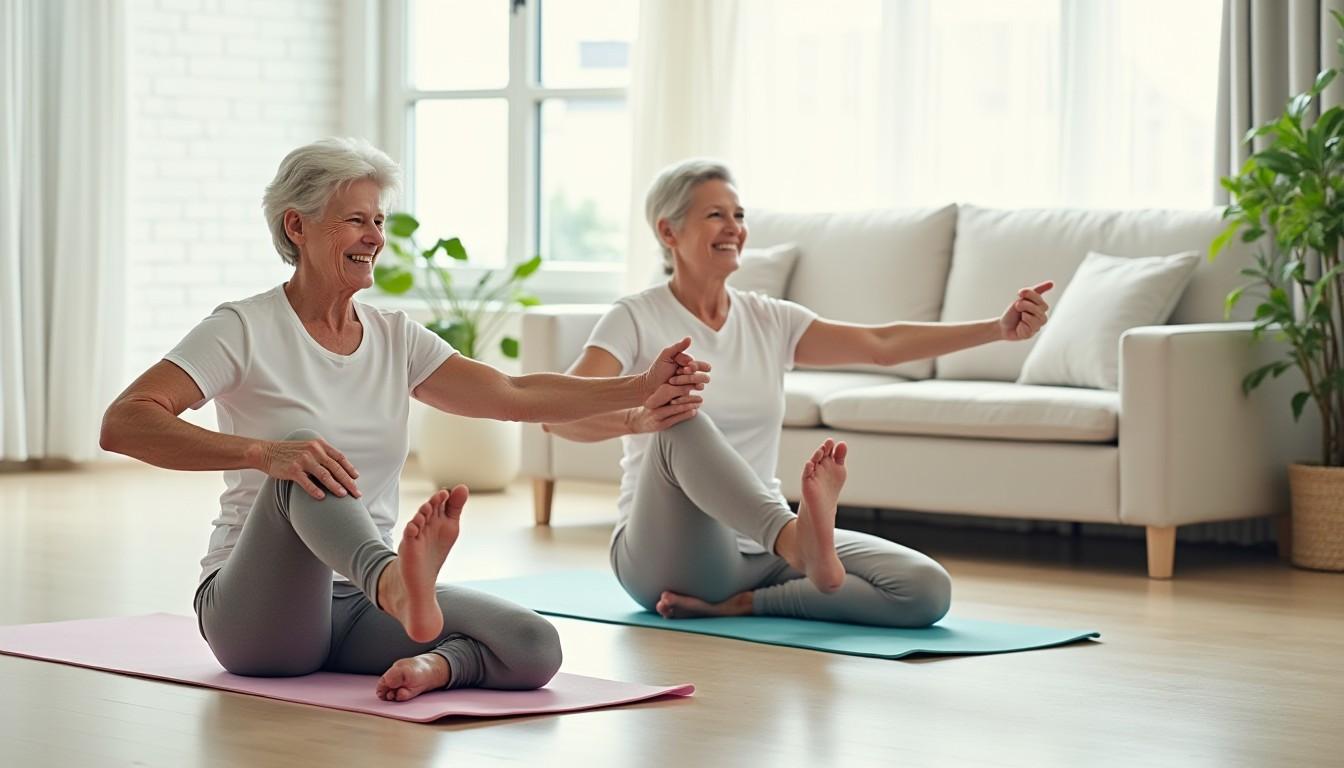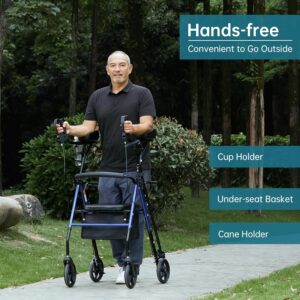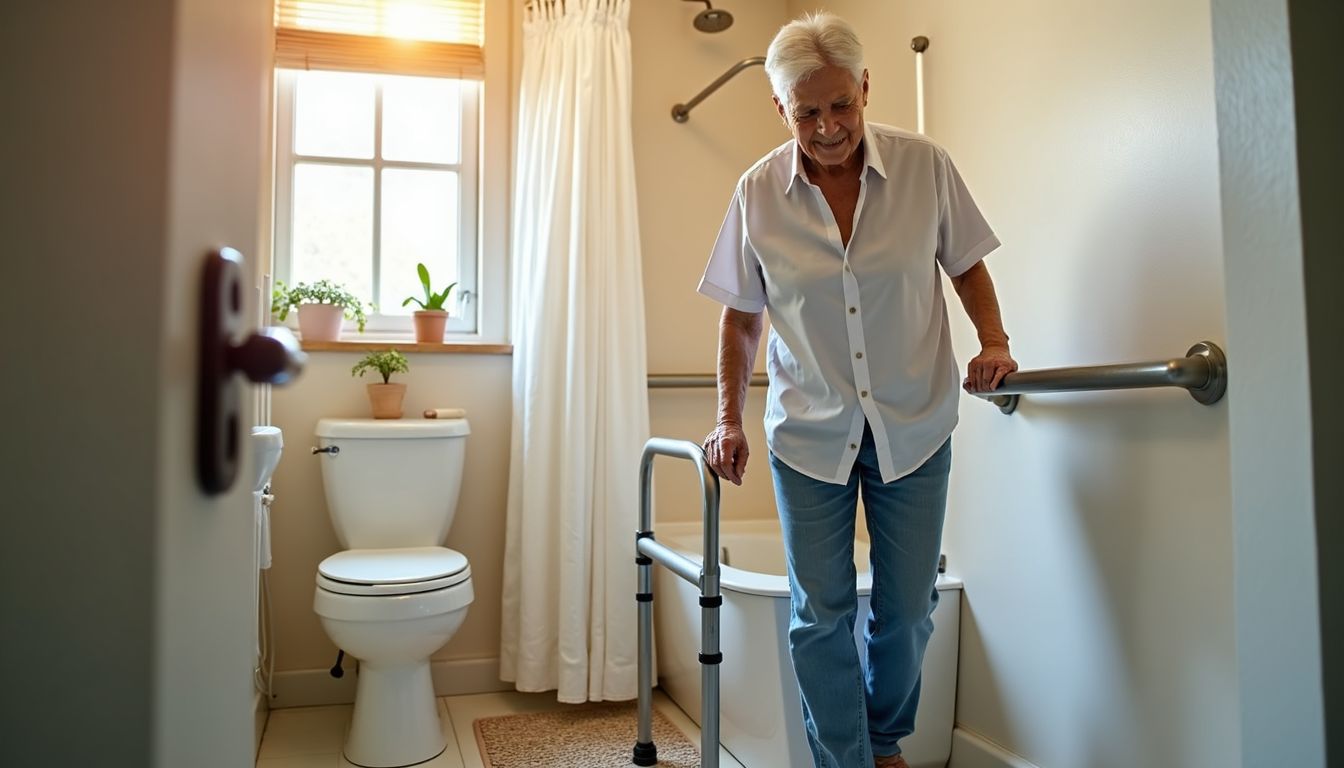Staying active is one of the best ways for seniors to maintain independence, prevent stiffness, and enjoy daily life without limitations. Simple exercises can improve balance, strength, and flexibility — all of which reduce the risk of falls and injuries. In this guide, we’ll share 10 easy mobility exercises for seniors that are safe, effective, and can be done right at home without special equipment.
Unlike heavy workouts, mobility exercises are gentle, safe movements that help keep joints flexible, muscles relaxed, and the body balanced. Think of them as little routines that keep you moving freely — whether you’re 60, 70, or beyond.
In this blog, we’ll look at 10 easy mobility exercise examples that seniors can practice daily, even at home. These simple moves can reduce stiffness, improve balance, and help you stay active without needing any fancy equipment.
What Are Mobility Exercises?
Mobility exercises are gentle movements designed to improve the range of motion in your joints. They’re not about building muscle or burning calories like regular workouts — instead, they focus on helping your body move smoothly and comfortably.
For seniors, mobility exercises can make everyday tasks easier, such as:
-
Reaching for items on a shelf
-
Turning your head while driving
-
Sitting down and standing up without strain
-
Walking steadily without losing balance
It’s important to note that mobility is different from flexibility. Flexibility means how far your muscles can stretch, while mobility means how well you can move your joints through their natural range. For example, you might have flexible hamstrings but still struggle to squat if your hip mobility is limited.
In simple words: flexibility is about stretching, mobility is about moving — and seniors need both, but mobility plays a key role in independence.
Benefits of Mobility Exercises for Seniors
Before we dive into the examples of mobility exercise, it’s important to understand why these simple moves matter so much. Mobility exercises may look easy, but their impact on a senior’s daily life is huge.
🌟 Key Benefits:
-
Improves balance and stability – Regular mobility movements reduce the risk of falls, which are a common concern for seniors.
-
Reduces joint stiffness – Gentle exercises keep joints lubricated, easing discomfort from arthritis or aging.
-
Supports independence – When your body moves freely, everyday tasks like cooking, bathing, or walking become much easier.
-
Boosts circulation and energy – Mobility exercises get the blood flowing, which can help reduce fatigue.
-
Helps with posture – Better joint mobility supports a healthier spine and reduces slouching.
In short, practicing mobility daily means staying active, confident, and less dependent on others.
10 Easy Examples of Mobility Exercise for Seniors
Mobility doesn’t mean heavy workouts or fancy gym routines. Instead, it’s all about small, gentle movements that keep your body flexible, strong, and ready for daily activities. Here are 10 safe and effective examples of mobility exercise seniors can start today.
1. Neck Rotations (For Better Flexibility in the Neck)
How to do it:
-
Sit or stand upright.
-
Slowly turn your head to the left until you feel a light stretch.
-
Hold for 3–5 seconds, then slowly turn to the right.
-
Repeat 5–10 times.
Why it helps:
Neck stiffness is common in aging adults. This simple movement improves flexibility, reduces tension, and makes daily tasks like checking blind spots while driving safer.
2. Shoulder Rolls (For Looser Shoulders and Upper Back)
How to do it:
-
Sit or stand with your arms relaxed.
-
Lift your shoulders up toward your ears, roll them back, then drop them down.
-
Repeat 10 times backward, then 10 times forward.
Why it helps:
Shoulder rolls release tension from sitting too long and improve posture — something that becomes more important as we age.
3. Arm Circles (For Improved Shoulder Mobility)
How to do it:
-
Stretch your arms out to the sides at shoulder level.
-
Make small forward circles 10 times, then switch to 10 backward circles.
-
You can make the circles larger as you get more comfortable.
Why it helps:
This movement improves circulation in the arms and increases flexibility, making it easier to reach overhead or lift light objects.
4. Wrist Rotations (For Healthy Joints and Grip Strength)
How to do it:
-
Extend your arms in front of you.
-
Rotate your wrists slowly in a circular motion, 10 times clockwise and 10 times counter-clockwise.
Why it helps:
Wrist rotations are great for seniors who struggle with arthritis or weak grip. This keeps the wrists flexible, making tasks like writing, cooking, or holding a cup much easier.
5. Ankle Circles (For Balance and Stability While Walking)
How to do it:
-
Sit in a sturdy chair or stand holding onto a wall for support.
-
Lift one foot slightly off the floor and slowly rotate your ankle in circles.
-
Do 10 circles clockwise, then 10 counter-clockwise. Switch legs.
Why it helps:
Ankle strength is directly linked to balance. Stronger, more flexible ankles reduce the risk of falls when walking on uneven ground.
6. Seated Leg Extensions (For Stronger Knees and Easier Standing)
How to do it:
-
Sit in a chair with feet flat on the floor.
-
Extend your right leg forward until it’s straight, hold for 2–3 seconds, then lower it.
-
Repeat 10–12 times for each leg.
Why it helps:
This exercise strengthens the quadriceps and supports knee joints. Seniors who struggle with standing up from chairs or climbing stairs benefit greatly from this.
7. Hip Circles (For Lower Back and Hip Flexibility)
How to do it:
-
Stand with feet shoulder-width apart and place hands on hips.
-
Slowly rotate your hips in a big circle 5 times clockwise, then 5 times counter-clockwise.
Why it helps:
Hip circles loosen up stiff joints and keep the pelvis area flexible. This helps seniors move more comfortably while walking, bending, or getting out of bed.
8. Seated Side Bends (For Spine Mobility and Core Strength)
How to do it:
-
Sit tall in a sturdy chair.
-
Place your right hand on the chair for support and raise your left arm overhead.
-
Gently lean to the right side, hold for 5 seconds, then return. Switch sides.
-
Repeat 5–8 times each side.
Why it helps:
This move stretches the spine and strengthens the oblique muscles, improving posture and reducing back stiffness.
9. Standing Marches (For Hip Mobility and Cardiovascular Health)
How to do it:
-
Stand tall with feet hip-width apart.
-
Slowly lift your right knee as high as comfortable, then lower it.
-
Alternate legs as if marching in place.
-
Do 20–30 marches.
Why it helps:
Standing marches build hip mobility, improve circulation, and prepare the body for walking longer distances.
10. Heel-to-Toe Walk (For Balance and Coordination)
How to do it:
-
Stand straight and walk in a straight line.
-
Place the heel of one foot directly in front of the toes of the other foot.
-
Take 10–15 careful steps, using a wall or chair for support if needed.
Why it helps:
This is one of the best examples of mobility exercise for balance training. It strengthens stabilizing muscles and helps prevent falls — a top concern for seniors.
🛡️ Safety Tips for Doing Mobility Exercises
While mobility exercises are gentle and safe for most seniors, it’s always best to exercise with care. Here are some tips to keep your workouts safe and enjoyable:
-
Warm Up First – Start with 2–3 minutes of light marching in place or gentle stretching. This warms up the muscles and prevents injuries.
-
Go Slow & Controlled – Don’t rush the movements. Focus on smooth, controlled motions instead of speed.
-
Use Support if Needed – Hold on to a sturdy chair, table, or wall for balance during standing exercises.
-
Listen to Your Body – Stop if you feel sharp pain, dizziness, or extreme discomfort. Mild stretching is okay, pain is not.
-
Wear Comfortable Shoes – Supportive footwear helps with balance and reduces the risk of slips.
-
Stay Hydrated – Even gentle exercises can make you sweat. Keep a glass of water nearby.
-
Check with Your Doctor – If you have chronic health conditions (like arthritis, osteoporosis, or heart disease), consult your healthcare provider before starting new exercises.
📅 How Often Should Seniors Do Mobility Exercises?
The beauty of mobility workouts is that they don’t require heavy effort, special equipment, or long hours. Here’s a simple routine to follow:
-
Daily: Perform 5–10 minutes of light mobility exercises in the morning or evening.
-
3–4 Times a Week: Do a full set of all 10 examples of mobility exercise for a complete routine.
-
Start Small, Build Up: Begin with 5 repetitions per exercise, and slowly increase to 10–15 as you get comfortable.
-
Pair with Walking: A short daily walk combined with mobility stretches creates the perfect senior-friendly fitness plan.
🧩 How to Fit Mobility Exercises Into Daily Life
Mobility doesn’t have to feel like a “workout.” You can sneak it into daily routines:
-
Do neck rotations while watching TV.
-
Try ankle circles while sitting at the dining table.
-
Practice heel-to-toe walking when going to the kitchen.
-
Do seated leg extensions whenever you’re sitting in a chair.
If you found these examples of mobility exercise helpful, why not try them today? Start with just 5 minutes, and slowly make it a daily habit. Small steps lead to big changes.
👉 Looking for tools to make exercising easier? Check out our recommended mobility aids for seniors — from supportive shoes to easy-grip exercise bands — in our [Product Reviews Section]. These simple tools can make your routine even safer and more enjoyable.
Stay active, stay independent, and remember — age is just a number when your body keeps moving! 💪✨
❓ Frequently Asked Questions About Mobility Exercises for Seniors
1. What are mobility exercises?
Mobility exercises are gentle movements designed to keep your joints flexible, improve your range of motion, and make everyday activities like walking, bending, or reaching easier. They are especially helpful for seniors who want to stay active and independent.
2. How often should seniors do mobility exercises?
Seniors can safely do mobility exercises every day. Even 5–10 minutes of simple stretching and movement can improve balance, reduce stiffness, and prevent falls.
3. What are the best examples of mobility exercise for older adults?
Some of the best examples of mobility exercise include neck rotations, shoulder rolls, ankle circles, seated leg extensions, and gentle yoga stretches. These movements are low-impact and safe for most seniors.
4. Do mobility exercises require equipment?
No. Most mobility exercises can be done using just your body weight and a sturdy chair for support. However, tools like resistance bands or balance balls can make workouts more engaging.
5. Can mobility exercises help with arthritis or joint pain?
Yes, regular mobility exercises can ease stiffness, improve circulation, and strengthen the muscles around your joints. Always consult your doctor before starting if you have severe arthritis.
6. Is walking a mobility exercise?
Walking is excellent for cardiovascular health and endurance, but it’s not the same as mobility exercises. Combining walking with mobility stretches creates a well-rounded fitness routine for seniors.
7. Are mobility exercises safe for seniors with health conditions?
In most cases, yes. Mobility exercises are low-impact and designed to be safe. However, if you have heart disease, osteoporosis, or serious joint problems, it’s best to consult your doctor before beginning.
✅ Conclusion
Mobility is the secret to staying independent, confident, and active as we grow older. By adding just a few minutes of gentle stretching and movement into your daily routine, you can make a big difference in how easily you move through life.
The 10 easy examples of mobility exercise we covered — from neck rotations to seated leg extensions — are simple, safe, and effective. You don’t need a gym membership or expensive equipment. All you need is a little consistency and a positive mindset.
Remember, the goal isn’t to push your limits — it’s to keep your body flexible, joints healthy, and balance steady. Whether you’re starting today or already on your fitness journey, mobility exercises are your best friend for healthy aging.







